chapter1_basic_concepts_of_strategic_management
MBA核心课程《Strategic Management》chapter1
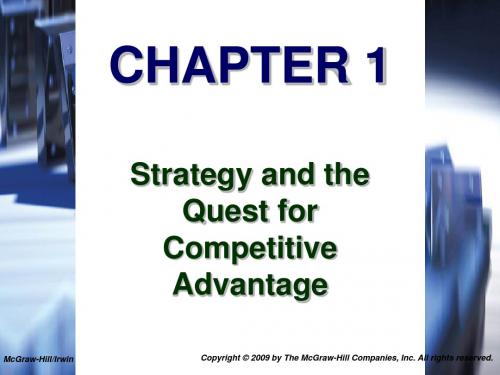
1-10
A Company’s Strategy Is a Blend of Planned Initiatives and Unplanned Reactive Adjustments
1-11
What Is a Business Model?
A business model addresses “How do we make money in this business?” Do the revenue-cost-profit economics of the strategy make good business sense?
1-12
Microsoft’s Business Model
Employ highly skilled programmers to develop proprietary code; keep source code hidden from users Sell resulting OS and software packages to PC makers and users at relatively attractive prices to achieve a 90% or more market share Most costs in developing software are fixed; variable costs are small; once break-even volume is reached, revenues from additional sales are almost pure profit Provide modest level of technical support to users at no cost Rejuvenate revenues by periodically introducing next-generation software that prompt PC users to upgrade their operating systems
战略管理概念与案例英文版.原书第十五版课程设计
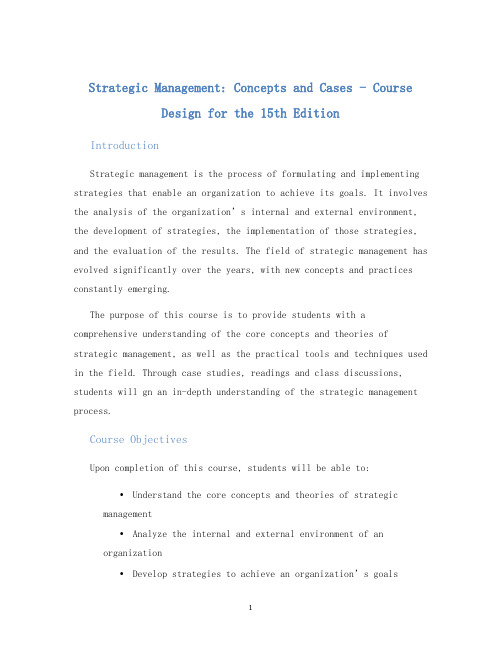
Strategic Management: Concepts and Cases - CourseDesign for the 15th EditionIntroductionStrategic management is the process of formulating and implementing strategies that enable an organization to achieve its goals. It involves the analysis of the organization’s internal and external environment, the development of strategies, the implementation of those strategies, and the evaluation of the results. The field of strategic management has evolved significantly over the years, with new concepts and practices constantly emerging.The purpose of this course is to provide students with a comprehensive understanding of the core concepts and theories of strategic management, as well as the practical tools and techniques used in the field. Through case studies, readings and class discussions, students will gn an in-depth understanding of the strategic management process.Course ObjectivesUpon completion of this course, students will be able to:•Understand the core concepts and theories of strategic management•Analyze the internal and external environment of an organization•Develop strategies to achieve an organization’s goals•Implement strategies effectively•Evaluate the results of strategic management initiatives Course StructureThe course will be divided into the following sections:Section 1: Introduction to Strategic Management•Overview of strategic management•Historical development of strategic management•Importance of strategic management•Key concepts in strategic managementSection 2: Analyzing the Environment•External environment analysis•Internal environment analysis•SWOT analysis•Porter’s Five Forces analysisSection 3: Strategy Development•Corporate-level strategy•Business-level strategy•International strategy•Competitive strategySection 4: Strategy Implementation•Organizational structure and design•Culture and leadership•Managing change•Resource allocationSection 5: Evaluation and Control•Measuring performance•Feedback and learning•Adjusting strategiesSection 6: Case Studies•Harvard Business School Case Studies•Other selected case studies Evaluation Criteria•Class participation (20%)•Written assignments (40%)•Case study analysis (20%)•Final exam (20%)TextbookThe textbook for this course is。
战略管理概念与案例

约定和行动
6
第六页,共四十三页。
1. Nature of Competition: Basic concepts
竞争力的特性: 基本概念
■ Competitive Advantage (CA) 竞争优势(CA)
■ Implemented strategy that competitors are unable to duplicate or find too costly to imitate
■ Strategic Management Process (SMP)战略管理过程(SMP)
■ Full set of commitments, decisions and actions required for a firm to achieve strategic competitiveness and earn above average returns
15
第十五页,共四十三页。
3. 21st Century Competitive Landscape
21世纪竞争格局
3.2.2 Technology and Technology Changes (Cont’d)
技术和技术进步
1) Technology diffusion技术扩散
■ Perpetual innovation: describes how new informationintensive technologies are replacing older forms持续创新 容信息密集型的新技术如何快速和有效地替代旧技术
■ Speed to market may be primary competitive advantage进入 市场的速度几乎成为最主要的竞争优势
Chapter1(1)

Properties:
- Finite (easy) - Correct (hard) - Efficient (complexity) - Input - Output
Classifications: Some differences:
- Numerical - Nonnumerical - Serial - Parallel -……
Analysis Basics
- Algorithm vs. Problem - Algorithm vs. Procedure - Algorithm vs. Program
What is a problem
Definition:
- A mapping/relation between a set of input instances (domain) and an output set (range)
Analysis Basics
Initializatio n is not very important!
Why and What to Analysis
Purposes:
- choose between algorithms of solving a given problem - count the number of basic operations with respect to N input values - analysis is done without regard to any specific computer
N characters in the file The number of assignment (=) is 257 The total time: f(N) as the time of a certain basic operation. E.g., f(N)=N+257+1. N∞, f(N) ≈ N
Strategic Management Concepts and Cases战略管理概念与案例

21st Century Competitive Landscap
■ Introduction: The Competitive Landscape (CL)
■ Pace of change i s rapid ■ P a r t n e r s h i p s c r e a t e d by mergers &a c q u i s i t i o n s (M& ■ Other CL c h a r a c t e r i s t i c s : Economies of s c a l e ,
· Destroy value of existing technology · Create new markets
12
21st Century Competitive Landscape
■ Technology and Technology Changes (Cont’d)
■ 1 . Technology d i f f u si o n &d i s r u p t i v e technologie ■ 2 . The information age ■ 3 . Increasing knowledge i n t e n s i t y
6
Chapter 1 : S t r a t e g i c Management and Strategic Competitiventent areas
■ Nature of Competition ■ The 21st Century Competitive Landscape ■ I/O Model of Above-Average Returns (AAR) ■ Resource-Based Model of AAR ■ Stra te gic Vision and Mission ■ Stakeholders ■ Strategic Leaders ■ The S t r a t e g i c Management Process
第一章战略历程明茨伯格Chapter1
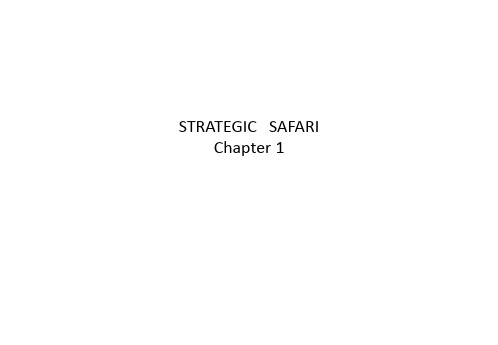
The Entrepreneurial School: strategy formation as a visionary process
The Cognitive School: strategy formation as a mental process The Learning School: strategy formation as an emergent process
Strategies for better and for worse
Strategy provides consistency
Advantage Strategy is needed to reduce ambiguity and provide order. In this sense, a strategy is like a theory : a cognitive structure to
Ansoff1965
70年代中 Purdue以 及1980、 1985年 Peter
Schu1950 , mpeter195 9及其他经 济学者
Simon1 947、 1957
学
派 根 基
Lindblom195 9、1968 Cyert March 1963Weick19 69 Quinn1980
Allison 1971Pfef ferSalan cik1978 Astley19 84
simplify and explain the world, and thereby facilitate action.
Ralph Waldo Emerson said that a foolish consistency is the hobgoblin of little minds….Creativity thrives on inconsistency—
国际经济与贸易专业主干课程 英文版

Syllabus of International Economics and Trade Names of Main Courses:1.International Clearance2.International Finance3.A Brief Introduction of International Trade4.International Trade Practice5.Customs Clearance Practices6.Management and Practice of Multinational Company7.Business Correspondence8.Trade negotiations9.Western EconomicsSyllabus of International FinanceFor: International Economics and TradeTotal Class Hours: 54Aims:This course introduces students to International Finance and equips them with basic concepts, and methods to study and analyze international economic issues and problems. It will lay a hard foundation for on Finance study and work in the future.Prerequisites:1.To understand properties, tasks and its researching targets; its system,structure overall2.To grasp basic concepts and theories, basic principles and methods,and development of international finance3.To learn to apply theories and principles to practice and analyzefinancial problems and specific cases with relevant theories.Teaching Mode:Lectures and case studyCourse Contents:Chapter one Foreign Currency and Exchange Rate1.1Definition and categories of currency1.2Definition, exchange quotation and categories of currency Rate1.3Currency basis and main factors affecting it1.4Function of currency changes to economyKey points and Difficulties:Exchange Quotation; main factors and functions of currency and currency changeChapter Two Currency System and Exchange Control2.1 Categories of currency system2.2 Fixed exchange rate and floating exchange rate2.3 History and purpose of exchange control2.4 Measures of exchange control2.5 Functions of exchange control2.6 Evolution and contents of foreign currency management in China2.7 RMB exchange rate system and its theoretical parityKey points and difficulties:Fixed exchange rate system and floating exchange rate system; pegging exchange rate, exchange control, complex exchange rate system, evasion, and arbitrage and Currency convertibilityChapter Three Foreign Exchange Market and Foreign Exchange Transactions3.1W hat is foreign exchange market3.2M ajor international markets and their transaction systems3.3T ransaction means3.3.1Spot transactions and forward transactions3.3.2Arbitrage trading and arbitrage trading3.3.3Swap3.3.4Foreign exchange futures and optionsKey points and difficulties:Foreign exchange market, foreign transaction, spot transaction and forward transaction; arbitrage trading and arbitrage trading, swap, foreign exchange futures and optionsChapter Four Foreign Exchange Risk Management4.1 What is exchange risk4.2 Causes and measures of exchange risk4.3 Enterprise Foreign exchange risk management approaches4.4 Bank Foreign exchange risk management approachKey points and difficulties:Recognize and measure all kinds of risks of foreign exchange and management approachesChapter Five International balance of payments5.1 What is international balance of payments5.2 Economic functions fo balance of payments5.3 Imbalance of international payments and its function5.4 Adjustment methods of imbalance of international paymentsKey points and difficulties:International balance of payments and its preparing methods; causes of imbalance and its functions to economy and adjustment methodsChapter Six International Reserves6.1 What are international reserves6.2 Management principles and policy options of international reserves 6.3 international reserves management in ChinaKey points and difficulties:International reserves, international liquidity, foreign exchange reserves, SDR; management principles and its functions,management principles in ChinaChapter Seven International Financial Markets7.1 What are international financial markets7.2 Classifications of international financial markets7.2.1 Foreign exchange market7.2.2 Money market7.2.3 Capital markets7.3 What are money markets in Europe7.4 Financial derivatives market7.4.1 Financial futures markets and futures trading rules7.4.2 Financial options market and options trading rulesKey points and difficulties:International financial markets, foreign exchange market, money markets, capital markets, money markets in Europe, offshore financial markets, financial derivatives; differences between offshore financial markets and traditional financial markets; financial derivatives trading rules and its supervision.Chapter Eight International Capital Flows8.1 What is international capital flows8.2 Benefits and risks of international capital flows8.3 International debt and its measurement index8.4 Causes and solutions of international debt crisis8.5 International capital flows and financial crisis in developing countries Key points and difficulties:Categories, contents and features of international capital flows; benefits and risks of international capital flowsChapter Nine International Settlement9.1N otes and documents in international settlement9.2M eans of international settlementKey points and difficulties:Categories and definitions of notes and documents in international settlement; different settlement means and usage; general business credit, standby letters of credit and bank guaranteeChapter Ten International Monetary Systems10.1 What are international monetary systems10.2 International monetary system10.2.1 International gold standard10.2.2 Bretton Woods system10.2.3 Jamaica monetary system10.3 Regional monetary system10.3.1 Effect of European Monetary System and European Monetary Union on economy10.4 Functions of European financial institutions in international monetary systemKey points and difficulties:International gold standard, Bretton Woods system, Jamaica monetary system, European Monetary Union, Euro; requirements of developing countries to international monetary system; History of Euro and its functions to world economyChapter Eleven International Finance Theory11.1 International balance of payments theory11.2 Exchange Rate Theory11.3 Theory of international capital flowsKey points and difficulties:Typical views on international balance of payments theory, such as Mercantilism’ theory of the balance of trade, Hume’s Price-cash flow mechanism; Purchasing power parity, psychological exchange, Export of capital, Capital input, Theory of capital controlsClass hour allocation:5 hours per chapter(4 hours for Chapter 11 only), totally 54 hours.Main references:Biaoru, C. (1990). Introduction of International Finance. Shanghai: Huadong Normal University Press.Obstfeld, P. R. K. M. (1998). International Economics. Beijing: Renmin University of China Press.Salvatore, D. (1998). International Economics. Beijing: Qinghua University Press.Shunian, L. (1995). International Finance. Beijing: International Business and Economics University Press.Xiang, T., & Yulu, C. (1996). International Finance and Management.Beijing: Renmin University of China Press.Syllabus of Introduction of International TradeFor: International Economics and TradeTotal Class Hours: 72Aims:This course introduces students to International trade and its theories and policies, and equips them with basic theories, viewpoints and methods to analyze international economic issues and trade problems. It will lay a hard foundation for on Finance study and work in the future.Courses contents:Part One Basis of International TradeChapter One Summary of international tradeAims and requirements:This chapter focuses on the researching objects, means and contents of international trade; students are required to master the basic concepts and the whole frame of international trade system.Key points and difficulties: researching objects, contents and basic conceptsChapter Two International Division of Labor and International Trade Aims and requirements:This chapter mainly touches on the relation between internationaldivision of labor and international trade; students are required to know factors causing labor division and different features of it at different stages; interactive relation between labor division and international trade. Key points and difficulties: main factors affecting international labor division.Chapter Three International Labor Division and World MarketAims and requirements:Students are required to know production and development of world market, systems and main features of world market and makeup and manifestations of price of world market.Key points and difficulties:Current world market systemChapter Four International Trade and Economic GrowthAims and requirements:Students are required to know the growing role of international trade in economy and the interactive relation between international trade and economic growth.Key points and difficulties:Economic growth’s effect to balance of international tradeChapter Five International Trade and Economic StructureAims and requirements:Studens are required to know the interactive relation between international trade and economic structure.Key points and difficulties:Infant industries and their protectionChapter Six Strategic Model of International TradeAims and requirements:Students are required to know the definition of Export and import substitution strategy and the main factors and selection principles affecting Export and import substitution strategyKey points and difficulties:Import substitution strategy and its theoretical basis, Export-oriented strategyPart Two International Trade TheoriesChapter Seven Classical International Trade ModelAims and requirements:Students are required to grasp the main theories of Mercantilism, absolute cost theory, comparative cost theory and Dornbush Fisher Samuelson Model.Key points and difficulties:Ricardo - Krugman modelChapter Eight Neoclassical International Trade ModelAims and requirements:Students are required to know Equilibrium open economy, mutual needs theory, factor endowment theory and Leontief MysteryKey points and difficulties:Mutual needs theory and factor endowment theoryChapter Nine Imperfect Competition Model of International TradeAims and requirements:Students are required to master scale economy and international trade, intraindustrial international trade, imperfect competitive market and International Competitive AdvantageKey points and difficulties:Intraindustrial international tradeChapter Ten Dynamic International Trade ModelAims and requirements:Students are required to master product life cycle theory, technological gap theory, technology spillover and “scientific” model and neoclassicaltheory.Key points and difficulties:Product life cycle theory and technological gap theoryChapter Eleven New Elements Model of International TradeAims and requirements:Students are required to know human capital and international trade; R&D and international trade, information and international trade, systems and international trade.Key points and requirements:Human capital and international tradeChapter Twelve Model of International Factor MobilityAims and requirements:Students are required to master international capital flow model, international factor and goods mobility and international technology mobility model.Key points and difficulties:International capital flow modelPart Three International Trade PolicyChapter Thirteen Introduction of International Trade PolicyAims and requirements:Students are required to know the evolution of international trade, options of international trade policy and its features, to lay a basis for future study.Chapter Fourteen Tariff MeasuresAims and requirements:Students are required to grasp rate of tariff protection and tariff effects models and know of tariff, tariff system and types of tariffKey points and difficulties:Tariff effects modelChapter Fifteen Non-tariff MeasuresAims and requirements:Students are required to grasp analysis of non-tariff effects and know types of non-tariff measures and its basic featuresKey points and difficulties:Analysis of non-tariff measure effectsChapter Sixteen Export Promotion and Export ControlAims and requirements:Students are required to grasp measures of export promotion and knowhow to analyze the economic effects export promotion and export control. Key points and difficulties:Measures of export promotionChapter Seventeen Strategic Trade PolicyAims and requirements:Students are required to know the theoretical basis of strategic trade policy, basic model and its applicationKey points and difficulties:Theoretical basis of strategic trade policyChapter Eighteen Political Economy of Trade PolicyAims and requirements:Students are required to know trade policy and political factors, rent-seeking and trade policy; game and coordination in international trade policy.Key points and difficulties:Trade policy and political factorPart Four International Trade TopicsChapter Nineteen World Trade Organization and International Trade Aims and requirements:Students are required to grasp the principles and main functions of WTO; know features of GATT related with WTO, analyze the relation among WTO, world trade and China.Key points and difficulties:Principles and functions of WTOChapter Twenty Regional Economic Integration and International Trade Aims and requirements:Students are required to know main content and forms, interactive relation and models of regional economic integrationKey points and difficulties:Models of regional economic integrationChapter Twenty One International Investment and TradeAims and requirements:Students are required to learn the main content and forms, interactive relation and theories of international investmentKey points and difficulties:International investment theoryChapter Twenty Two Transnational Corporation and International Trade Aims and requirements:Students are required to know general features of transnational corporation, major features of management and its effect on macro economyKey points and difficulties:Management of transnational corporationChapter Twenty Three International Trade in ServiceAims and requirements:Students are required to general features of transnational corporation, major features of management and its effect on macro economyKey points and difficulties:Models of international trade in serviceChapter Twenty Four International Trade PatternsAims and requirements:Students are required to know trade features of developed countries and developing countries; to know international economic order and trade patterns and their adjustments.Key points and difficulties:International economic order and trade patterns, and their adjustments.\Main referenceSalvatore, D. (1998). International Economics. Beijing: QingHua University Press.Xian, C. (1998). International Trade Shanghai Lixin Accounting Publishing HouseXinlei, S. (2001). Theories and Policies of International Economics.Chengdu: Southwestern University of Finance and Economics Press.Syllabus of International Trade PracticeFor: International economics and tradeTotal class hours: 36International Trade Practice is a backbone course of specialty of Trade Economics,and it is a course of studying the procedure of international exchange of commodities, and it also have characteristics of foreign activities. The task of this course is: In terms of practice and law, analyzing and studying various kinds of methods of international exchange of commodities, summarizing foreign practical experiences in order to carry out the principles and policies of foreign trade of our country, not only can guarantee the best economic benefits, but also can handle affairs according to the international practice, and make our basic methods can be generally accepted for the international community. Through this course students are required to master basic theories, knowledge and basic skill of the foreign trade business, understand the trade procedure of imports and exports and grasp the method and skill of drafting sales contract clauses.Part One International Trade TermsChapter One International Trade TermsAims:Trade term is the key content of this course. It requires students tograsp the explanations for 13 trade terms of INCO terms 2000 through studying, especially the definitions, characteristic and applications of some important trade term.Key points:The coverage of INCO terms 2000; the meaning of FOB, CFR, CIF, FCA ,CPT, CIP, shipment contract, Symbol Delivery, the varieties of trade term.Teaching difficulties:The same points and different points of FOB, CFR, CIF and the difference among FCA, CPT, CIP, summary of trade terms, choosing of trade terms.Teaching contentLaws and practices for sales of international cargo, the main content of sales contracts, general procedure of sale-goods and main content of this course.Part Two International Sale of GoodsChapter Two Name, Quality and PackingAims:This chapter requires students to study and grasp the importance concluding the quality clause and basic method in the sales contract through this Section, and grasp how to stipulate quantity clauses, andstudy the basic content of the packaging clause, and grasp the general description about the goods on the whole.Key points:Choosing the methods of descript quality correctly, using chipping mark, more and short clause and neutral packing.Teaching Difficulties:Related stipulations about quantity clause of ConversionChapter Three Transport of International GoodsAims:This Section is emphasis the modes of transport,how to stipulate the shipment clause in the contract,how to deal with the shipment document, especially the ocean transportation.Key points:Mode of ocean transport, related documents, clause, accounting the freight of line transportTeaching difficulties:Nature of B/L, kinds of B/L, stipulations about partial shipment and transshipment in UCP500Chapter Four Insurance of International GoodsAims:This Section tells mainly that transports the range that the cargo insurance gives cover for by sea, our country transports cargo insurance risk and such contents as the clause and transportation insurance practice of cargoes imported and exported, etc. by sea.Key points:Related knowledge about insurance of ocean transportTeaching difficulties:Decision of insurance amount, Choice of insurance averageChapter Five Price of International GoodsAims:Through the studying of this chapter, student can grasp the price of the imported and exported goods correctly, adopting various kinds of and fix a price for the method rationally, selecting the favorable pricing currency for use, using relevant commission and discount properly, and ordering the price clause in the contract.Key points:Accounting the commission and discount, exchange the price. Teaching difficulties:Choice to the method of accounting the priceChapter Six Collection and PaymentAims:This chapter mainly introduces the process of international settlement, such as means of payment, payment time, payment place, etc. Among them the L/C and its related issues are discussed in great details. This Section is a key Section of this book.Key points:Draft, L/C, International Factor and Choice of payment instruments. Teaching difficulties:Transferable L/C, relationship of 3 periods of L/C, Usance L/ C payable at sight.Chapter Seven Inspection, Claim, Arbitration and Force Majeure Aims:This chapter mainly introduces inspection, claim, arbitration, Force Majeure and related knowledge in international merchandise trade.Key points:Choosing the time and the place of inspection, deciding the claim party, stipulating the claim clause, judgment of Force Majeure matter, forms and functions of arbitration, results of arbitrationTeaching difficulties:Commencement and termination of Force MajeurePart Three Trade Negotiation and Contract PreparationChapter Eight Export Business Negotiation and Conclusion of ContractAims:This Section tells the general procedures of business negotiation, the basically contents and establishment of contract, etc.Key points:This Section is key on offer and accept, effective time, whether to revocable or withdraw.Teaching difficulties:Stipulations about offer and accept in ConventionChapter Nine Performance of Import and Export ContrastAims:This chapter mainly talks about the main steps in the general process in performance of the contract and its related issues that should be pay close attention to.Key points:The key points of Urging establishment of L/C, notices of verify the L/C Teaching difficulties:Auditing of credit amount and Export bill purchasePart Four International Trade FormsChapter Ten International Trade FormsAims:This chapter mainly tells about the concept and characteristic of various trade forms; main contents of various trade agreement; and issues of using various trade forms.Key points:Distribution, Sole Distribution, Solo Agent or Exclusive Agent, Consignment, Fairs and Sales, Invitation to Tender and Submission, Auction, Processing tradeTeaching difficulties:The Comparison of Sole Distribution and Solo Agent, differences of processing with imported material and supplied material.Main reference:Baifu, W. (1996). Textbook of Import and Export Trade Practice.Shanghai: Shanghai People's Press.Xiaoxian, L. (1994). International Trade Practice. Beijing University Press of International Business and Economics.Yongyou, Y. (1999). International Trade Practice. Wuhan: Hubei People's Press.。
英语第一章阅读 game theory 原文及翻译
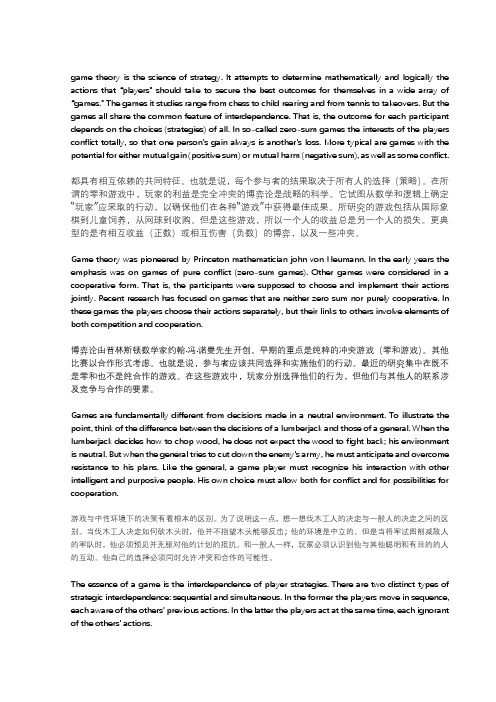
The essence of a game is the interdependence of player strategies. There are two distinct types of strategic interdependence: sequential and simultaneous. In the former the players move in sequence, each aware of the others’ previous actions. In the latter the players act at the same time, each ignorant of the others’ actions.
Game theory was pioneered by Princeton mathematician john von Neumann. In the early years the emphasis was on games of pure conflict (zero-sum games). Other games were considered in a cooperative form. That is, the participants were supposed to choose and implement their actions jointly. Recent research has focused on games that are neither zero sum nor purely cooperative. In these games the players choose their actions separately, but their links to others involve elements of both competition and cooperation.
chap001b Strategic Management
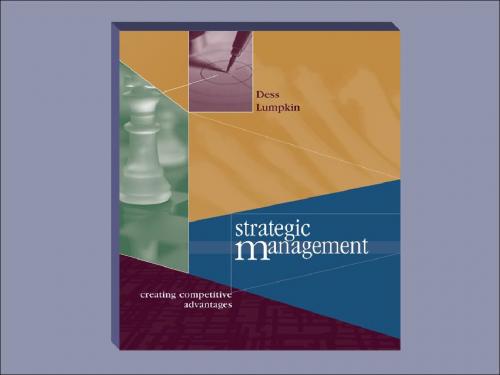
STRATEGIC MANAGEMENT McGraw-Hill/Irwin
CHAPTER 1
Gregory G. Dess and G. T. Lumpkin
Copyright © 2003 by The McGraw-Hill Companies, Inc. All rights reserved.
Restructuring, reengineering & refocusing the organization Legend Major impact Minor impact Strategic control & continuous improvement
Strategic Management Principle
Chapter 7 Formulating International Strategies
Chapter 10
Implementation: Organization Design
Chapter 11
Strategic Leadership: Excellence, Ethics, and Change
Chapter 2
Analyzing the External Environment
Chapter 3
Analyzing the Internal Environment
Chapter 4
Assessing Intellectual Capital
Strategy Analysis
Chapter 5
Set Objectives
Revise as Needed
Revise as Needed
Improve/ Change
国际商务谈判chapter1
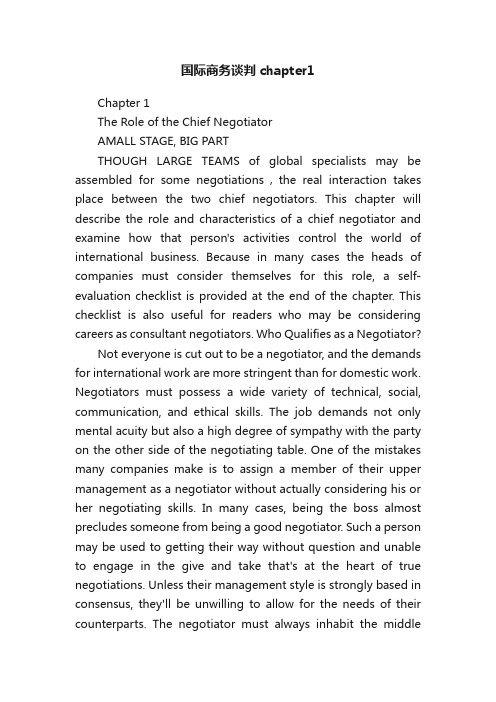
国际商务谈判chapter1Chapter 1The Role of the Chief NegotiatorAMALL STAGE, BIG PARTTHOUGH LARGE TEAMS of global specialists may be assembled for some negotiations,the real interaction takes place between the two chief negotiators. This chapter will describe the role and characteristics of a chief negotiator and examine how that person's activities control the world of international business. Because in many cases the heads of companies must consider themselves for this role, a self-evaluation checklist is provided at the end of the chapter. This checklist is also useful for readers who may be considering careers as consultant negotiators. Who Qualifies as a Negotiator?Not everyone is cut out to be a negotiator, and the demands for international work are more stringent than for domestic work. Negotiators must possess a wide variety of technical, social, communication, and ethical skills. The job demands not only mental acuity but also a high degree of sympathy with the party on the other side of the negotiating table. One of the mistakes many companies make is to assign a member of their upper management as a negotiator without actually considering his or her negotiating skills. In many cases, being the boss almost precludes someone from being a good negotiator. Such a person may be used to getting their way without question and unable to engage in the give and take that's at the heart of true negotiations. Unless their management style is strongly based in consensus, they'll be unwilling to allow for the needs of their counterparts. The negotiator must always inhabit the middleground. He (or she) must enter the negotiation process with the understanding that both teams must leave the table with a sense that they've received "enough." The negotiator's job is to maximize the long-term benefits of the venture while securing short-term needs.The Chief NegotiatorThe chief negotiator (CN) is responsible for unifying the strategy, tactics and overall style to be used by a particular company. He must exercise a high degree of self-control and keep the team on track under trying circumstances. Once the strategy and tactics have been determined, team discipline demands that all decisions regarding changes must have the CN as the focal point. While strategic consensus is important, delegation of responsibility is of little value. The stakes in international business are very high, and the CN must be willing to accept total responsibility for the outcome. This will be true even when subordinates have made key decisions.The CN’s greatest skill is the ability to deal with pressure from a variety of directions. Headquarters, clients, team members, family, negotiating counterparts, and government officials will all demand attention. The CN must be a decision maker who can keep everyone satisfied without being distracted from the pre-established priorities. Handling these responsibilities within a foreign environment, and possibly in a foreign language, isn't a job for the faint of heart. Special problems often arise between a CN who has been brought in on a consultancy basis and personnel who’ve been made members of the negotiating team primarily for their technical skills. These conflicts must be worked out far in advance of negotiations. This will be discussed in more detail later but the rea der is cautioned at this stage that one ofthe CN’s duties is to present a unified and coherent一致的negotiating agenda at all times.How Much Technical Knowledge is Required?Government regulations and corporate specifications make technical requirements a key part of negotiations. Besides the actual specifications of the product at hand, the logistical movement ofthe product across national borders may, in and of itself, require great technical insight. This is often the case in high-tech and telecommunication projects. While it's certainly necessary for CNs to be thoroughly briefed on the technical aspects of the negotiation, it's by no means a requirement that they be experts. Should the subject of the negotiations be highly technical in nature, team members will supply the proper technical backup when required. The CN must devote his attention to the larger picture.Candidates for CN should be technically astute with regard to both the company's products and modern day information technology. Most international business people now travel with laptop computers (notebook, sub-notebook or palm-top) in order to compactly carry along the vast amount of data necessary for quick decision making. These "electronic team members" can greatly reduce the number of personnel required to make presentations and/or assist in technical decisions. These machines also bring the added ability to make the CN, or team, more productive during travel or downtime. The CN must not be a casual or neophyte user of this technology as his competence may be judged at meetings by his ability to handle the newest hardware and software. In some ways, the laptop has become as useful, and potentially embarrassing (when they don't work), asthe slide projector of yore. Laptops can also become a security risk.Character TraitsSHREWDNESSThe CN, whether staff or consultant, carries the entire responsibility and trust of the company when acting on its behalf. The successful CN must be capable of: allowing the other side to see only what serves the strategy best, and this requires an ethical mixture of honesty and cunning. Forthrightness is a trait to avoid when selecting a CN, People who "wear their hearts on their sleeves" or insist on transparency in all dealings will make sorry negotiators in the global marketplace. While there's no room for duplicity, the CN must know which cards to lay on the table and when. For this reason, shrewdness heads the list for desirable characteristics. PATIENCEPatience is an indispensable attribute. Negotiations can be quite taxing—each offer brings a counteroffer and every maneuver a countermaneuver, while delays eat up time and energy. Corrupt officials, petty management, and incompetent staff members all must be handled with care. As will be seen in the sections on bias, some countries make patience a cultural requirement for working in their economic sector. Regardless of the locale, a CN who "flies off of the handle" will be of little use in international negotiations.ADAPTABILITYBecause negotiations are concerned with each side getting the other to change positions, the CN must be highly adaptable. Having an inflexible strategy and limited tactics will almost instantly bring negotiations to an unproductive close. Beyond the preplanned contingencies, the CN must be able to respondquickly and decisively to unforeseen developments. Negotiations seldom go completely according to plan, nor will they always change in preconceived patterns. Being able to "think on your feet" will go a long way toward success at the conference table.ENDURANCEWhile negotiating is primarily a mental activity, it can be physically demanding. The CN must be available for all sessions and eight-hour days will be rare. Add in travel fatigue, climatic changes, jet lag, foreign food, late-night socializing, and work stress and you have the makings of burnout. Many cultures use the tactic of physically and mentally wearing down their counterpartsin order to achieve concessions. The CN (and the entire team) must be on guard against fatigue,and there is no better place to start than during the selection process. Physical fitness, endurance, and a reasonably abstemious nature are highly desirable, and bankable, attributes in a CN.GREGARIOUSNESSNegotiating is by nature a social process. Many countries have little in the way of commercial contract law, and the success of the deal in such circumstances is based on trust and friendship. Even when the deal is bound by contract, the "relationship" will play a huge role in finalizing it. A competent CN is gregarious by disposition and excels in social settings. Just as many deals are made across the dinner table as are made across the conference table. The ability to hold a good, off-business-topic conversation with a counterpart, even in trans lation, will only advance the CN’s position. Remember, concessions must be extracted from adversaries but they're given by friends. CONCENTRATION International business can make substantial demands on itspractitioners. Time zone changes, language problems, and legal wranglings can all be major distractions from the goals set forth in the strategy. The potential for "losing track" is enormous. Many an executive has returned from an overseas negotiating trip with either a diminished sense of accomplishment or a firm belief that nothing went according to plan. For this reason, the ability to concentrate on those issues at the heart of the negotiation is an asset the CN cannot afford to be without. Counterparts will often attempt to put as many points as possible "on the table" in an effort to cloud the main issue. The CN must be able to maintain the team's (and his own) focus at all times.THE ABILITY TO ARTICULATEPeople who can't communicate their ideas or understand those put forth by counterparts are of little use around the negotiating table. Good CNs must be practiced listeners as well as articulate speakers. Everything about them—from their demeanor, to their clothes, to their body language, to how they handle subordinates—will be scrutinized. A CN must also have a keen sense of what is motivating his counterparts in order to communicate the proper image. Make no mistake, the negotiating arena is a stage, albeit small, and CNs play the largest roles.SENSE OF HUMORNegotiating can be a very stressful affair, and there will be moments when it hardly seems worth the effort A CN must be equipped with a highly developed sense of humor in order to weather persistent storms. Some of the negotiating delays, logistical problems, and social settings may seem like exercises in absurdity, and many of the discomforts of travel can be downright demeaning. Viewing such problems with a humorouseye and avoiding the syndrome of taking yourself too seriously can make all the difference in keeping negotiations on track. Organizational QualitiesWhen working overseas, the CN embodies the company in image and practice. Consequently, the CN must be highly organized in order to effectively handle the vast number of problems that will inevitably arise. The CN must be able to select, motivate, and control a team operating under high-stress conditions. He also must be able to arrange and rearrange schedules, as well as oversee staff in difficult circumstances. Every and any logistical detail can make the difference between success and failure.Because administrative support teams will be unavailable to all but the largest corporations, the negotiating team (or perhaps the CN alone) will be left to its own resources. Problems must be foreseen far in advance, and team members assigned to each task. There's little room for error. Every negotiating session should be preceded by a strategy session and followed by a recap. The professional CN leaves no detail unexamined.The Importance of Team SolidarityWhenever possible, the CN should have full control over the selection of negotiating team members. This is key, because the team must think as a unit at all times and have total respect for, confidence in, and loyalty to the CN. There can be no "turf wars" or disputes over the CN's authority or assignments. This may seem extreme to believers in less hierarchical management structures. However, high stakes, stresses, and the adversarial nature of international negotiations can't tolerate anything less than a unified effort if success is to be attained.caution: Dissention within a team will be exploited bycounterparts to the fullest extent.While team members will have varying levels of authority and responsibility, ' all direction must come from the CN. Any actions that depart from the preordained strategic, tactical, or contingency plans must be discussed with and condoned by the CN. As we will see later, Divide and Conquer is a very common negotiating technique, and the only defense against it is seamless unity. Lastly, because of the need for centralized decision making, it's wise to appoint a second in command (in case illness or calamity should befall the CN).Self-EvaluationIn smaller companies, it's often the case that a member of upper management is called upon to act as the CN. This can be for overseas negotiations or in the domestic market should a foreign company come calling. Although it may be necessary for top management to sign-off on the contract or attend meetings for appearances sake, it's by no means necessary that they actually negotiate the deal. In some cases, it may be contrary to the company’s be st interest to have upper management involved, at least until the details have been finalized. The following checklist can be used by managers, owners, or anyone else wishing to consider a career in international negotiations.SELF-SELECTION QUESTIONNAIRE YES NO1. Do I have the necessary time and attention to devote tothese crucial negotiations? ( ) ( )2. Am I the most experienced member of the organization interms of international business? ( ) ( )3. Do I understand the culture and commercial nuances ofmy counterparts? ( ) ( )4. Are my language skills suitable for the negotiation? ( ) ( )5. Have I ever worked with a translator before? ( ) ( )6. Have I negotiated major contracts before? ( ) ( )7. Am I physically well enough to engage in extended (Continued for a long period of time) and stressful negotiations? ( ) ( )8. Do I have the organizational skills to lead a team that's notentirely of my own choosing? ( ) ( )9.Do 1 have the technical expertise to run the negotiation? ( ) ( )10. Am I capable of working sixteen hours a day? ( ) ( )11. Am I at ease in unusual social situations? ( ) ( )12. Am I capable of living in physically demanding circumstances? ( ) ( )13. Do I find other cultures easy to accept? ( ) ( )14. Am I considered a patient person by my peers and subordinates? ( ) ( )15. Am 1 considered an extrovert? ( ) ( )16. Am I capable of accepting full responsibility for the ( ) ( )outcome of these negotiations? ( ) ( ) 17. Are my organizational skills optimal for leadingthe negotiation team? ( ) ( )18. Have I traveled overseas for extended periods on business before? ( ) ( )19. Will my absence from home cause me only slightemotional distress?( physical discomfort) ( ) ( )20. Will my absence from home cause my family only slightemotional distress? ( ) ( )If you found yourself answering "no" to any of these twenty questions, you may wish to re-evaluate your potential role as chief negotiator.What to Look For in a Potential CN ConsultantSometimes the right person to fill the role of CN will not be found within your company, or it could be that the best person for the job can't be spared from their domestic duties. In both instances, an outside company or consultant must be found. Keep in mind that, in some cases, the CN is the only representative of your company at the negotiations, while at other times, the CN's role is to advise your team on strategy and tactics. Either way, making a correct choice and a "good fit" will ultimately determine the success of your strategy. Here are some major points to consider.Match ethics Make it clear to candidates that you want the negotiations conducted in a specific manner. Check references thoroughly on this point. It's even advisable to resort to role-playing in order to assess the consultant's ability to act in accordance with your company's ethical standards. ?match cultures Negotiating in Japan is not like negotiating in Brazil. Make sure that the consultant has relatable experience in the target market. Language skills are helpful bur not absolutely necessary. If the consultant claims fluency in specific languages, put these to the test prior to making the decision to hire. The same goes for dialects. Remember, Cantonese is of limited use in Beijing.match technical prowess Most consultants specialize in specific industries or services. While some will insist that they can negotiate "anything, anywhere, anytime," you'll be best served by someone who has some expertise in your product or service. This is especially true in high-tech, telecom, and financial services.match commitment Because of the intensity of international negotiations, you can't afford to have a detached, dispassionateCN—consultant or not. The successful candidate must perform as if their own company's future is at stake. If the candidate gives you the impression that this is just another overseas assignment, end the interview. He or she must be deeply and noticeably committed to your success. The counterparts across the table should not be able to detect that your consultant CN is anything other than an employee of your company. In many cases, consultants are given company logo business cards with a staff title, such as "Vice President of Overseas Planning," in order to blur the consultant/employee distinction.note: It's advisable to check your home country's laws on independent contractors prior to issuing the cards or titles.match loyalty Many consultants complain of being given the responsibility for making the negotiations work and then having their authority undermined at every turn. Conversely, headquarters management often complains of consultants who are determined to follow their own agendas. Neither case is acceptable. Consultant CNs are paid to define strategy and execute prearranged tactics. They must be given 100 percent control of the negotiations and of any staff who may accompany them. In return, the consultant CN must tow the company line to whatever degree management stipulates. All of this must be made clear contractually far in advance of the negotiations. If the company can't find a consultant CN they can fully trust, it's best to forgo the hire. If the company recognizes other useful qualities in the candidate, it may wish to use him or her as an assistant to a staff CN.Match motivations The majority of consultants will charge for both expenses and fees. Expenses should allow the CN to project an image that befits the company. (Don't underestimate the valueof appearances.) Fees should be commensurate with the prospective CN's experience and the size of the project. Fees should also include payments for attaining specific portions of the strategy. Financial motivation feeds commitment. Consultants who will not agree to performance-based pay are best avoided.。
Basic Concepts of the Theory of Sets
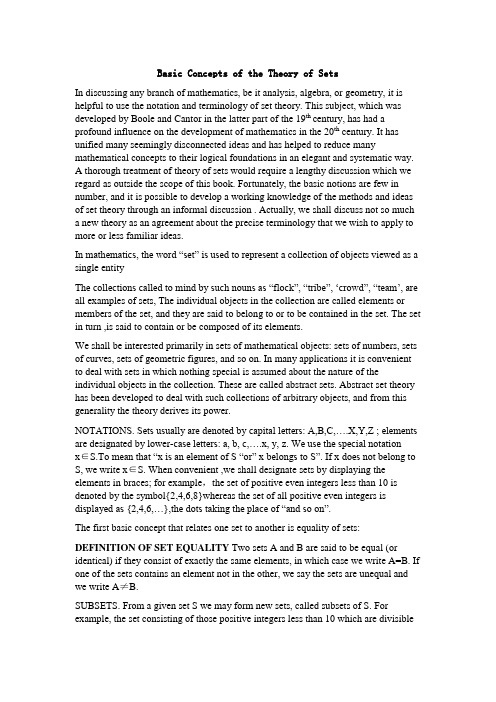
Basic Concepts of the Theory of SetsIn discussing any branch of mathematics, be it analysis, algebra, or geometry, it is helpful to use the notation and terminology of set theory. This subject, which was developed by Boole and Cantor in the latter part of the 19th century, has had a profound influence on the development of mathematics in the 20th century. It has unified many seemingly disconnected ideas and has helped to reduce many mathematical concepts to their logical foundations in an elegant and systematic way.A thorough treatment of theory of sets would require a lengthy discussion which we regard as outside the scope of this book. Fortunately, the basic notions are few in number, and it is possible to develop a working knowledge of the methods and ideas of set theory through an informal discussion . Actually, we shall discuss not so much a new theory as an agreement about the precise terminology that we wish to apply to more or less familiar ideas.In mathematics, the word “set” is used to represent a collection of objects viewed as a single entityThe collections called to mind by such nouns as “flock”, “tribe”, …crowd”, “team‟, are all examples of sets, The individual objects in the collection are called elements or members of the set, and they are said to belong to or to be contained in the set. The set in turn ,is said to contain or be composed of its elements.We shall be interested primarily in sets of mathematical objects: sets of numbers, sets of curves, sets of geometric figures, and so on. In many applications it is convenient to deal with sets in which nothing special is assumed about the nature of the individual objects in the collection. These are called abstract sets. Abstract set theory has been developed to deal with such collections of arbitrary objects, and from this generality the theory derives its power.NOTATIONS. Sets usually are denoted by capital letters: A,B,C,….X,Y,Z ; elements are designated by lower-case letters: a, b, c,….x, y, z. We use the special notationx∈S.To mean that “x is an element of S “or” x belongs to S”. If x does not belong to S, we write x∈S. When convenient ,we shall designate sets by displaying the elements in braces; for example,the set of positive even integers less than 10 is denoted by the symbol{2,4,6,8}whereas the set of all positive even integers is displayed as {2,4,6,…},the dots taking the place of “and so on”.The first basic concept that relates one set to another is equality of sets:DEFINITION OF SET EQUALITY Two sets A and B are said to be equal (or identical) if they consist of exactly the same elements, in which case we write A=B. If one of the sets contains an element not in the other, we say the sets are unequal and we write A≠B.SUBSETS. From a given set S we may form new sets, called subsets of S. For example, the set consisting of those positive integers less than 10 which are divisibleby 4(the set {4, 8}) is a subset of the set of all even integers less than 10.In general, we have the following definition.DEFINITION OF A SUBSET.A set A is said to be a subset of a set B, and we write A⊂B.Whenever every element of A also belongs to B. We also say that A is contained in B or B contains A. The relation is referred to as set inclusion.The statement A⊂B does not rule out the possibility that B A. In fact, we may have both A⊂B and B⊂A, but this happens only if A and B have the same elements. In other words, A=B if and only if A⊂B and B⊂A .This theorem is an immediate consequence of the foregoing definitions of equality and inclusion. If A⊂B but A≠B, then we say that A is a proper subset of B: we indicate this by writing A⊂B.In all our applications of set theory, we have a fixed set S given in advance, and we are concerned only with subsets of this given set. The underlying set S may vary from one application to another; it will be referred to as the universal set of each particular discourse.The notation {x∣x∈S. and x satisfies P} will designate the set of all elements x in S which satisfy the property P. When the universal set to which we are referring id understood, we omit the reference to S and we simply write{x∣x satisfies P}.This is read “the set of all x such that x satisfies p.” Sets designated in this way are said to be described by a defining property For example, the set of all positive real numbers could be designated as {X∣X>0};the universal set S in this case is understood to be the set of all real numbers. Of course, the letter x is a dummy and may be replaced by any other convenient symbol. Thus we may write {x∣x>0}={y∣y>0}={t∣t>0} and so on .It is possible for a set to contain no elements whatever. This set is called the empty set or the void set, and will be denoted by the symbol φ. We will consider φto be a subset of every set. Some people find it helpful to think of a set as analogous to a container (such as a bag or a box) containing certain objects, its elements. The empty set is then analogous to an empty container.To avoid logical difficulties, we must distinguish between the element x and the set {x} whose only element is x , (A box with a hat in it is conceptually distinct from the hat itself.)In particular, the empty set φis not the same as the set {φ}.In fact, the empty set φcontains no elements whereas the set {φ} has one element φ(A box which contains an empty box is not empty).Sets consisting of exactly one element are sometimes called one-element sets.UNIONS, INTERSECTIONS, COMPLEMENTS. From two given sets A and B, we can form a new set called the union of A and B. This new set is denoted by the symbol A∪B(read: “A union B”). And is defined as the set of those elements which are in A, in B, or in both. That is to say, A∪B is the set of all elements which belong to at least one of the sets A,B.Similarly, the intersection of A and B, denoted by A∩B(read: “A intersection B”) is defined as the set of those elements common to both A and B. Two sets A and B are said to be disjoint if A∩B=φ.If A and B are sets, the difference A-B (also called the complement of B relative to A)is defined to be the set of all elements of A which are not in B. Thus, by definition, A-B={X|X∈A and X B}. The operations of union and intersection have many formal similarities with (as well as differences from) ordinary addition and multiplications of union and intersection, it follows that A∪B=B∪A andA∩B=B∩A. That is to say, union and intersection are commutative operations. The definitions are also phrased in such a way that the operations are associative:(A∪B)∪C=A∪(B∪C)and(A∩B)∩C=A=∩(B∩C).The operations of union and intersection can be extended to finite or infinite collections of sets.VocabularySet 集合proper subset 真子集Set theory 集合论universal set 泛集Branch 分支empty set 空集Analysis 分析void set 空集Geometry 几何学union 并,并集Notation 记号,记法intersection交,交集Terminology 术语,名词表complement余余集Logic 逻辑relative to 相对于Logical 逻辑的finite有限的Systematic 系统的disjoint不相交Informal 非正式的infinite无限的Formal正式的cardinal number基数,纯数Entity 实在物ordinal number序数Element 元素generality一般性,通性Abstract set 抽象集subset子集Designate 指定,divisible可除的Notion 概念set inclusion 集的包含Braces 大括号immediate consequence 直接结果Identical 恒同的,恒等的Notes1. In discussing any branch of mathematics, be it analysis, algebra, or geometry, it is helpful to use the notation and terminology of set theory.意思是:在讨论数学的任何分支时,无论是分析,代数或几何,利用集合论的记号和术语是有帮助的。
FRM 金融风险管理师考试大纲

Quantitative Analysis Readings:
1. Linda Allen, Jacob Boudoukh, Anthony Saunders, Understanding Market, Credit and Operational Risk: The Value At Risk Approach (Oxford: Blackwell Publishing, 2004). Chapter 2 – Quantifying Volatility in VaR Models th John Hull, Options, Futures, and Other Derivatives, 6 ed. (New York: Prentice Hall, 2006). Chapter 19 – Estimating volatilities and correlations rd Philippe Jorion, Value at Risk: The New Benchmark for Managing Financial Risk, 3 ed. (New York: McGraw-Hill, 2007). Chapter 9 – Forecasting risk and correlations Chapter 12 – Monte Carlo Methods Lampros Kalyvas and Ioannis Akkizidis, Integrated Market, Credit and Operational Risk: A Complete Guide for Bankers and Risk Professionals (London: Risk Books, 2006). Chapter 4 – Extreme Value Theory and in Risk Management Murray R. Spiegel, John Schiller, and R. Alu Srinivasan, Probability and Statistics, Schaum’s Outlines, 2nd ed. (New York: McGraw-Hill, 2000). Chapter 1 – Basic Probability Chapter 2 – Random Variables and Probability Distributions Chapter 3 – Mathematical Expectation Chapter 4 – Special Probability Distributions Chapter 5 – Sampling Theory Chapter 6 – Estimation Theory Chapter 7 – Tests of Hypotheses and Significance Chapter 8 – Curve Fitting, Regression, and Correlation NOTE: Candidates should not memorize formulas of distributions but should understand when it is appropriate to use a particular type of distribution.
金字塔原理第一章解读

金字塔原理第一章解读(中英文实用版)Title: The Pyramid Principle - Chapter 1 InterpretationThe Pyramid Principle is a book that delves into the art of logical thinking and effective communication.The first chapter sets the stage for understanding the concept of thinking in a structured manner.在《金字塔原理》这本书中,作者深入探讨了逻辑思维和有效沟通的艺术。
第一章为读者理解结构化思维的概念奠定了基础。
The chapter emphasizes the importance of creating a clear and concise message that is easily understood by others.It highlights the significance of using a top-down approach in presenting information, starting with the main idea and then gradually expanding on supporting details.本章强调了创建清晰简洁的信息对于他人易于理解的重要性。
它突出了在呈现信息时采用自上而下的方法的重要性,从主要观点开始,然后逐渐扩展到支持性细节。
Furthermore, the chapter introduces the concept of "thinking in pyramid structure," which involves organizing ideas in a hierarchical manner.This structure allows for a more focused and organized presentation of thoughts, making it easier for the audience to follow and understand the message being conveyed.此外,本章介绍了“金字塔结构思维”的概念,涉及以层次化的方式组织思想。
戴维战略管理:理论与案例——获取竞争优势方法第14版英文第1章战略管理性质

Defining Strategic Management
❖ Strategic management is used
synonymously with the term strategic planning.
Defining Strategic Management
❖ Strategic management
the art and science of formulating, implementing, and evaluating crossfunctional decisions that enable an organization to achieve its objectives
14 Copyright © 2013 Pearson Education, Inc. publishing as Prentice Hall
Key Terms in ent
answers the question “What do we want to become?”
4 Copyright © 2013 Pearson Education, Inc. publishing as Prentice Hall
Defining Strategic Management
❖ A strategic plan is a company’s game
plan.
❖ A strategic plan results from tough
❖ Strategic management helps a firm
启蒙辩证法英文原著
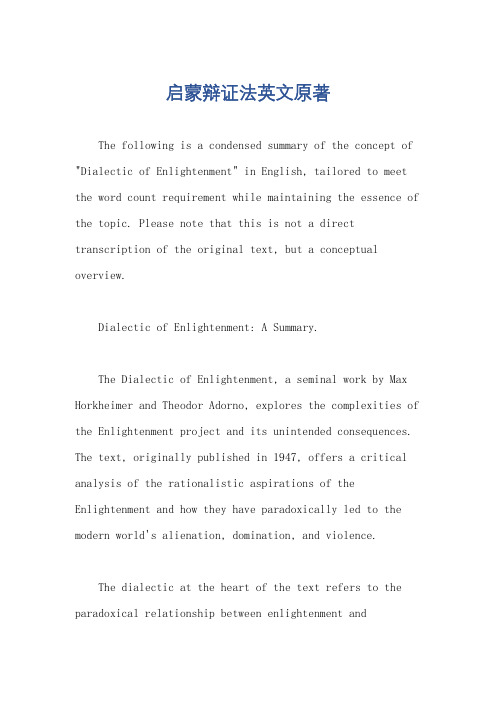
启蒙辩证法英文原著The following is a condensed summary of the concept of "Dialectic of Enlightenment" in English, tailored to meet the word count requirement while maintaining the essence of the topic. Please note that this is not a direct transcription of the original text, but a conceptual overview.Dialectic of Enlightenment: A Summary.The Dialectic of Enlightenment, a seminal work by Max Horkheimer and Theodor Adorno, explores the complexities of the Enlightenment project and its unintended consequences. The text, originally published in 1947, offers a critical analysis of the rationalistic aspirations of the Enlightenment and how they have paradoxically led to the modern world's alienation, domination, and violence.The dialectic at the heart of the text refers to the paradoxical relationship between enlightenment andbarbarism. On the one hand, the Enlightenment's quest for reason, science, and progress promised to liberate humanity from superstition and ignorance. However, Adorno and Horkheimer argue that this quest has ultimately failed, leading instead to a new form of domination and alienation.The authors posit that the Enlightenment's emphasis on rationality and control has resulted in the commodification of nature and human beings. Science and technology, once tools of liberation, have become mechanisms of domination, serving to oppress rather than emancipate. The modern world, they argue, is characterized by a "reign of quantity" where qualitative aspects of life are subordinated.。
企业战略管理英文版(第一章)

The Strategic Management Process
Strategic Objectives & Inputs
Ch. 1: Strat. Chapter 1: Chapter 3: Mgmt. & Com- The External Strategic Management Environment petitiveness Strategic Competitiveness Chapter 4: Ch. 2: Strat. The Internal Mgmt . & Performance Environment Strategic Mission & Strategic Intent
Chapter 10: Cooperative Strategy
© 2006 by Nelson, a division of Thomson Canada Limited.
1-6
What is Strategy?
• An integrated and coordinated set of commitments & actions designed to exploit core competencies and gain a competitive advantage.
© 2006 by Nelson, a division of Thomson Canada Limited.
1-11
an *
*
Resources and capabilities
that meet these four criteria become a source of:
chapter1 basic concepts of strategic management
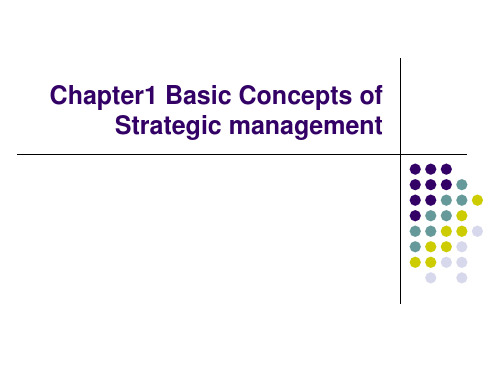
Strategic management process
A sequential set of analyses and choices that can increase the likelihood that a firm will choose a good strategy.
Chapter1 Basic Concepts of Strategic management
Definition of strategy
A firm’s theory about how to gain competitive advantage
A set of assumptions and hypotheses about the way competition in our industry is likely to evolve, and how that evolution can be exploited to earn a profit. But, it is difficult to predict precisely how competition in an industry will evolve, and to know for sure what is the right strategy. This is why a firm’s strategy is almost always a theory. It is a company’s best bet about the future.
the_six_disciplines_of_strategic_thinking_范文模板及概述
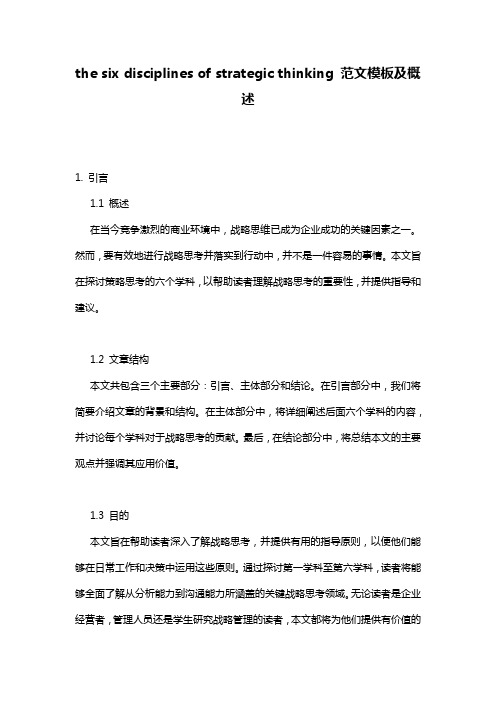
the six disciplines of strategic thinking 范文模板及概述1. 引言1.1 概述在当今竞争激烈的商业环境中,战略思维已成为企业成功的关键因素之一。
然而,要有效地进行战略思考并落实到行动中,并不是一件容易的事情。
本文旨在探讨策略思考的六个学科,以帮助读者理解战略思考的重要性,并提供指导和建议。
1.2 文章结构本文共包含三个主要部分:引言、主体部分和结论。
在引言部分中,我们将简要介绍文章的背景和结构。
在主体部分中,将详细阐述后面六个学科的内容,并讨论每个学科对于战略思考的贡献。
最后,在结论部分中,将总结本文的主要观点并强调其应用价值。
1.3 目的本文旨在帮助读者深入了解战略思考,并提供有用的指导原则,以便他们能够在日常工作和决策中运用这些原则。
通过探讨第一学科至第六学科,读者将能够全面了解从分析能力到沟通能力所涵盖的关键战略思考领域。
无论读者是企业经营者,管理人员还是学生研究战略管理的读者,本文都将为他们提供有价值的见解和实用的工具。
2. 主体部分:2.1 第一学科- 分析能力:在战略思维中,分析能力是至关重要的一个学科。
它涉及到对内部和外部环境的深入了解和评估。
通过有效的分析,企业可以识别出自身的优势和劣势,并发现市场机会和竞争威胁。
这包括对市场趋势、行业竞争、消费者需求和公司资源等因素进行全面而系统性的分析。
从而为未来制定战略决策提供可靠的依据。
2.2 第二学科- 创新能力:战略思维需要创新能力来开拓新的商机和应对变革。
创新能力意味着不断寻找并实施独特的解决方案,以满足客户需求并保持竞争优势。
这涵盖了产品创新、服务改进、流程优化以及技术应用等各个方面。
创新使企业能够在日益激烈的市场竞争中保持领先地位。
2.3 第三学科- 战略定位能力:战略定位是指确定企业如何在市场中与竞争对手区分开来,以获得持续优势和利润增长。
这需要考虑市场的需求、定位的独特性以及企业资源的配置等因素。
ACCANotesSBL笔记2
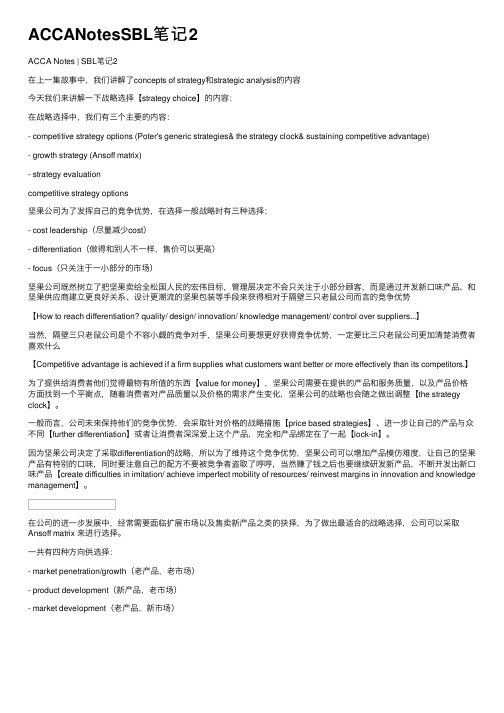
ACCANotesSBL笔记2ACCA Notes | SBL笔记2在上⼀集故事中,我们讲解了concepts of strategy和strategic analysis的内容今天我们来讲解⼀下战略选择【strategy choice】的内容:在战略选择中,我们有三个主要的内容:- competitive strategy options (Poter's generic strategies& the strategy clock& sustaining competitive advantage)- growth strategy (Ansoff matrix)- strategy evaluationcompetitive strategy options坚果公司为了发挥⾃⼰的竞争优势,在选择⼀般战略时有三种选择:- cost leadership(尽量减少cost)- differentiation(做得和别⼈不⼀样,售价可以更⾼)- focus(只关注于⼀⼩部分的市场)坚果公司既然树⽴了把坚果卖给全松国⼈民的宏伟⽬标,管理层决定不会只关注于⼩部分顾客,⽽是通过开发新⼝味产品、和坚果供应商建⽴更良好关系、设计更潮流的坚果包装等⼿段来获得相对于隔壁三只⽼⿏公司⽽⾔的竞争优势【How to reach differentiation? quality/ design/ innovation/ knowledge management/ control over suppliers...】当然,隔壁三只⽼⿏公司是个不容⼩觑的竞争对⼿,坚果公司要想更好获得竞争优势,⼀定要⽐三只⽼⿏公司更加清楚消费者喜欢什么【Competitive advantage is achieved if a firm supplies what customers want better or more effectively than its competitors.】为了提供给消费者他们觉得最物有所值的东西【value for money】,坚果公司需要在提供的产品和服务质量,以及产品价格⽅⾯找到⼀个平衡点,随着消费者对产品质量以及价格的需求产⽣变化,坚果公司的战略也会随之做出调整【the strategy clock】。
- 1、下载文档前请自行甄别文档内容的完整性,平台不提供额外的编辑、内容补充、找答案等附加服务。
- 2、"仅部分预览"的文档,不可在线预览部分如存在完整性等问题,可反馈申请退款(可完整预览的文档不适用该条件!)。
- 3、如文档侵犯您的权益,请联系客服反馈,我们会尽快为您处理(人工客服工作时间:9:00-18:30)。
opportuni ties
threats
SWOT analysis
Evolution of strategic management
Influence of technology(2000-)
Development of internet Boom of venture Entrepreneurship Organization learning Knowledge based view Strategic alliance International strategy
Evolution of strategic management
Emphasize firm internal capability(1990-2000)
Resource based view of the firm Core competence Network theory
strength weakness
Learning organization
Dynamic environments
Less time for one product or technology to replace another. No permanent competitive advantage
Develop strategic flexibility . Strategic flexibility demands long-term commitment to critical resource. Learning organization: skilled at creating, acquiring, and transferring knowledge, and modifying its behavior to reflect new knowledge and insights.
Chapter1 Basic Concepts of Strategic management
Definition of strategy
A firm’s theory about how to gain competitive advantage
A set of assumptions and hypotheses about the way competition in our industry is likely to evolve, and how that evolution can be exploited to earn a profit. But, it is difficult to predict precisely how competition in an industry will evolve, and to know for sure what is the right strategy. This is why a firm’s strategy is almost always a theory. It is a company’s best bet about the future.
Evolution of strategic management
Strategic planning(1950-1970)
How to control business division of the business group? Business policy Corporate planning department Focus on external environments Diversification M-form Product portfolio matrix
Definition of strategy
Strategic management is that set of managerial decisions and actions that determines the longrun performance.
Environment scanning Strategy formulation Strategy implementation Evaluation and control
operation
marketing
finance
MIS
HBR
Initiation of strategy
Initiatioห้องสมุดไป่ตู้ of strategy
Strategy formulation is typically not a regular, continuous process. Strategic drift simply be a result of the organization’s inertia, or manager’s belief that the current strategy still appropriate. Trigger events
Status of strategic management
Strategic management
Organization management
Research has revealed organization that engage in strategic management generally outperform those that do not.
Evolution of strategic management
Industry organization Modeling(1980-1990)
Michael Porter
Competitive strategy: techniques for analyzing industries and competitors, 1980 Competitive advantage: creating and sustaining superior performance, 1985 Competitive of advantage of nations, 1990 Provide tools for analyzing firm external environments
